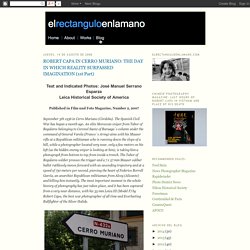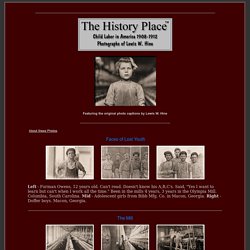

Huffingtonpost. What America’s immigrants looked like when they arrived on Ellis Island. We hear so often that America is "a nation of immigrants" or a "cultural melting pot" that the phrase has become kind of a tired cliche.

But actually seeing that history is a different story. The fascinating photographs below — of people in their native dress passing through Ellis Island in the early 20th century — hint at just how incredible and unique America's history is as a nation of immigrants. These photos were taken by Augustus Sherman, an amateur photographer who worked as the chief registry clerk on Ellis Island from 1892 until 1925. Sherman snapped these photographs of people passing through customs in their native dress. They were published in National Geographic in 1907 and once hung on the walls in the headquarters of the federal Immigration Service in Manhattan, according to the Public Domain Review. The history of the island is not always a happy one: It also reflects deep racism and ethnic divisions.
Here is a young German man, who the notes classify as a "stowaway": M.fastcompany. Look closely at Oliver Michaels's black-and-white "Architectural Composites.

" (Like nose-to-monitor close.) Only then do you realize that something's amiss. There are no doors or windows into the buildings; they hew to the same square silhouette; and feature a jigsaw of materials, embellishments, and patterns. While they appear to be quirky designs, none of the buildings physically exist as Michaels depicts them. Rather, he's cobbled together details and surfaces from dozens of photographs shot in the same area and composed his own architecture. "Fred Ritchin [dean of the school at the International Center of Photography] links the breaking of the human genome to the digitization of photography," Michaels says.
Preferring overcast days for even lighting, Michaels walks through neighborhoods and snaps images of interesting textures or features using a Canon 5D. Get the latest Fast Company stories in your inbox daily. Soul, el corto sobre la cámara Leica ya acumula 17 premios - Número f. Según publica el blog Leica News & Rumors, el cortometraje "Soul", que fue creado para el lanzamiento de la cámara M-Monochrom en la tienda de Leica en São Paulo, y que se ha vuelto viral en los últimos días en la redes sociales, ganó cinco premios en el Festival de Cannes Lions y un total de 17 premios internacionales.

Esta producción no está relacionada con Leica Camera AG, fue creada de forma independiente por la productora Sentimental Filmes ,de FNazca / Saatchi & Saatchi. Leica - Alma. ROBERT CAPA & LA FOTO DEL MILIZIANO - Photographers.it - la vetrina dei fotografi sul mondo. Elrectanguloenlamano: ROBERT CAPA IN CERRO MURIANO: THE DAY IN WHICH REALITY SURPASSED IMAGINATION (1st Part) DIFFICULTIES OF LOCATION OF THE PLACE OF THE PHOTOGRAPHRobert Capa made his mythical photograph on the so called Cerro de La Coja, on a spot in its most eastward slope near the beginning of a little ravine, from which you can see the mountains appearing in the background of the photograph, on the right of the militiaman who is instantly killed by a bullet piercing his heart.

After having visiting a lot of times this Cerro de La Coja hill (as well as Torreárboles, Las Malagueñas and the village of Cerro Muriano itself with its current streets), it must be concluded almost without any margin for error in this respect that Capa made his most renowned photograph on the Cerro de la Coja, located in the outskirts of the village of Cerro Muriano, in its east zone, as you look at it arriving from Córdoba in south-north direction. Leitz Elmar 35 mm f/3.5 uncoated, featuring 4 elements in 3 groups. Another great Tessar design by the legendary Max Berek. HOW DID ROBERT CAPA MAKE THE PHOTOGRAPH? How Capa's camera does lie: The photographic proof that iconic 'Falling Soldier' image was staged. By Mail Foreign Service Updated: 16:29 GMT, 21 July 2009 It's the iconic photo that captures the essence of the Spanish Civil War: a soldier falling to his death, arms splayed out behind him, gun still in hand, after being shot on a grassy hill.

Robert Capa, Gerda Taro, David Seymour 'Chim' en la Guerra Civil. Culture - Robert Capa at 100: The war photographer’s legacy. Culture - Leica: The camera that snapped a century. Culture - Robert Capa at 100: The war photographer’s legacy. Historia en femenino. Son decenas los periodistas que, cada año, se dejan la piel por contarnos qué sucede en los conflictos bélicos alrededor del mundo.

Sólo en 2012, 67 profesionales de la información murieron mientras realizaban su trabajo en territorio hostil. Nuestra protagonista de hoy tiene el triste honor de ser la primera mujer fallecida mientras ejercía como periodista de guerra. Sin embargo, es mucho más que eso. Fue una auténtica pionera del fotoperiodismo, y, junto a su pareja, el célebre Robert Capa, puso rostros y miradas a la Guerra Civil española. Hoy nos acordamos de Gerda Taro. Child Labor in America: Investigative Photos of Lewis Hine. About these Photos Faces of Lost Youth Left - Furman Owens, 12 years old.

Can't read. Doesn't know his A,B,C's. Said, "Yes I want to learn but can't when I work all the time. " The Mill Left - A general view of spinning room, Cornell Mill.